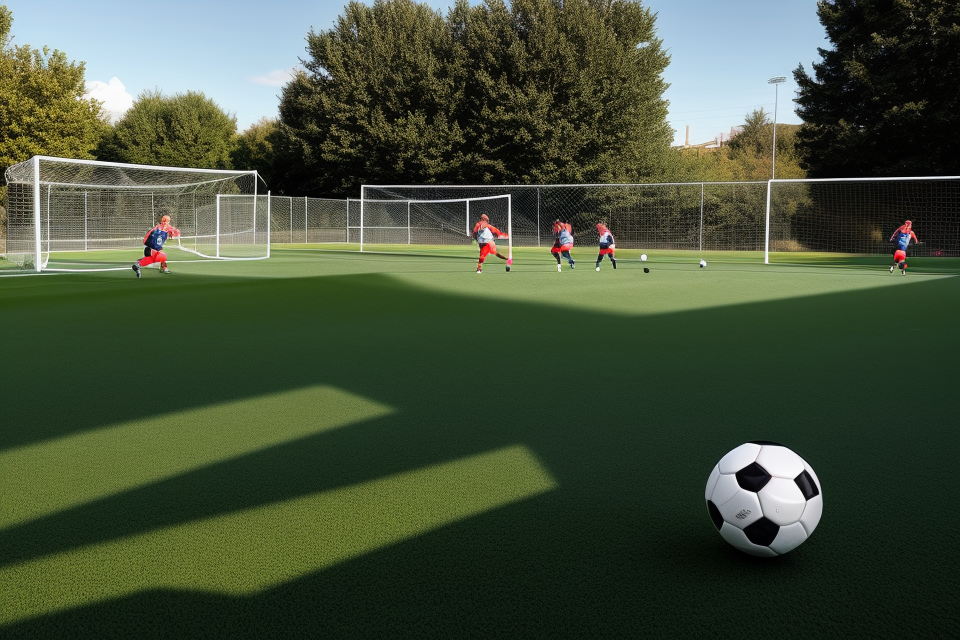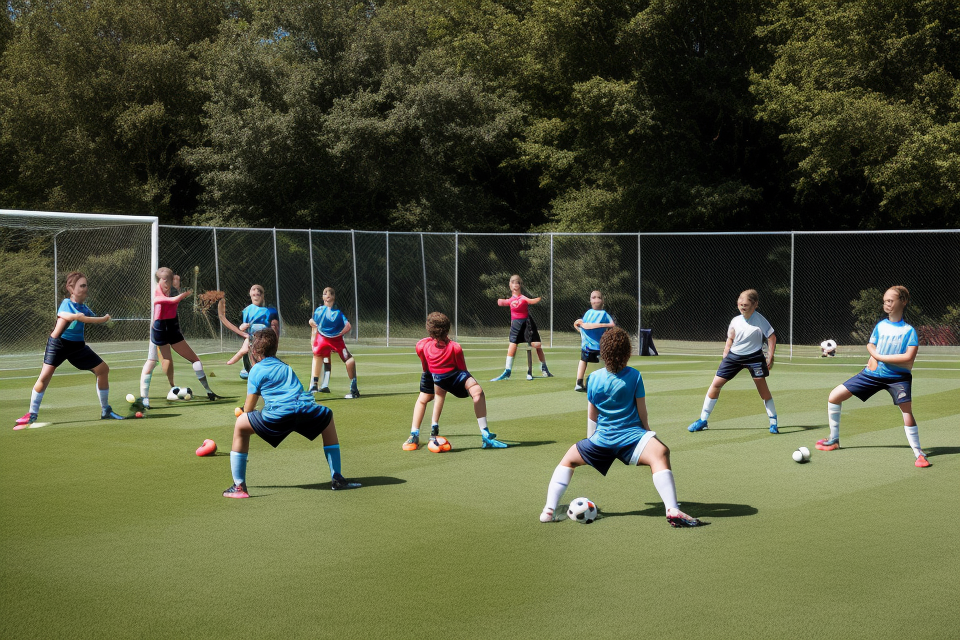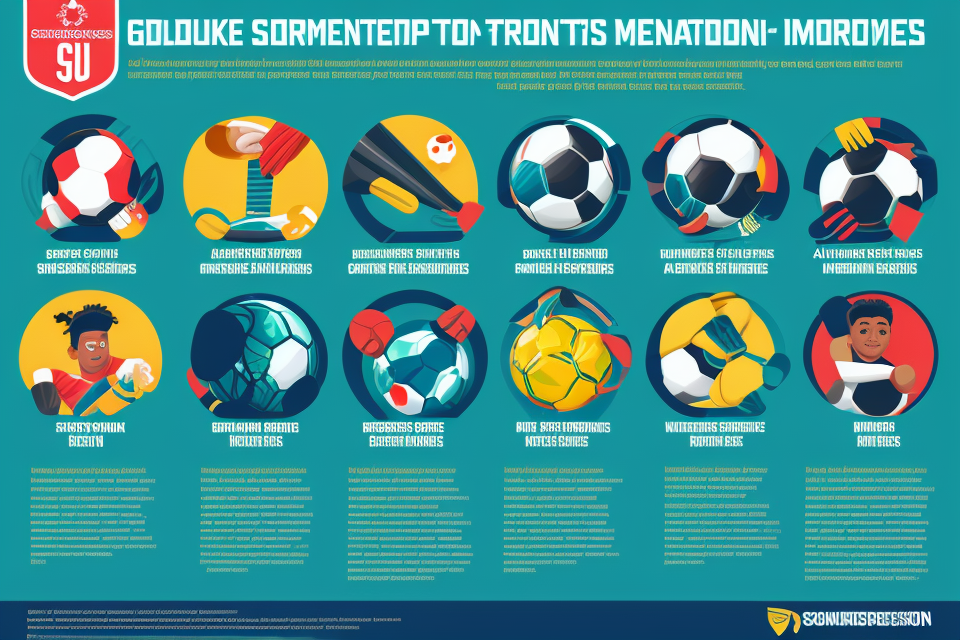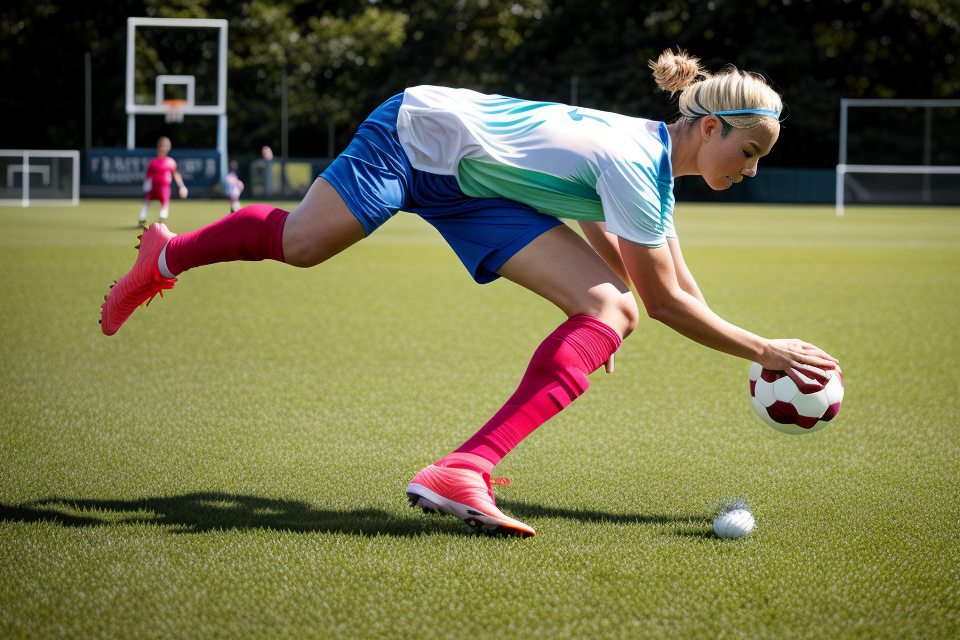Injury prevention in sport is a crucial aspect of any athlete’s training regimen. It involves implementing measures to reduce the risk of injury and promote overall health and fitness. In soccer, injuries are common due to the high intensity and physical demands of the game. This comprehensive guide will provide a detailed overview of how to effectively prevent injuries in soccer, including exercises, drills, and strategies to improve strength, flexibility, and agility. Whether you’re a beginner or an experienced player, this guide will provide valuable insights to help you stay injury-free and perform at your best on the field.
Understanding Soccer Injuries
Common Types of Soccer Injuries
Soccer is a physically demanding sport that requires players to be in top condition to perform at their best. However, with the high level of competition and physicality involved in the game, injuries are an unfortunate but common occurrence. In this section, we will discuss some of the most common types of soccer injuries and their causes.
- Muscle strains: Muscle strains are one of the most common injuries in soccer. They occur when a muscle is stretched beyond its limits, resulting in tears in the muscle fibers. Muscle strains can occur in any part of the body but are most common in the hamstring and groin areas. These injuries are often caused by overuse, lack of proper warm-up, or sudden changes in direction or speed.
- Ligament sprains: Ligament sprains are another common injury in soccer. They occur when a ligament, which connects bones together, is stretched or torn. Ligament sprains can occur in any part of the body but are most common in the knee and ankle joints. These injuries are often caused by sudden changes in direction or collisions with other players.
- Concussions: Concussions are a type of injury that occurs when the brain is subjected to a violent movement or impact. Concussions can occur in soccer when a player headbutts the ball or collides with another player’s head. Symptoms of a concussion include dizziness, confusion, and memory loss. If a player experiences any of these symptoms, they should immediately stop playing and seek medical attention.
- Ankle injuries: Ankle injuries are a common occurrence in soccer, especially when players are changing direction quickly or jumping for a ball. Ankle sprains, which occur when a ligament in the ankle is stretched or torn, are the most common type of ankle injury. Other types of ankle injuries include fractures and tendinitis.
- Knee injuries: Knee injuries are another common occurrence in soccer, especially in players who have weak or poorly conditioned leg muscles. Knee injuries can range from minor sprains to more serious injuries such as tears in the ligaments or cartilage. Common knee injuries in soccer include anterior cruciate ligament (ACL) tears and medial collateral ligament (MCL) sprains.
Factors Contributing to Soccer Injuries
- Poor training techniques: One of the main factors contributing to soccer injuries is poor training techniques. This can include improper exercises, lack of supervision, or inadequate training facilities.
- Lack of proper equipment: Soccer players should use appropriate footwear and protective gear to prevent injuries. Wearing the wrong shoes or not wearing shin guards can increase the risk of injuries.
- Insufficient warm-up and cool-down exercises: A proper warm-up and cool-down is essential to prevent injuries. Warming up helps to prepare the muscles for physical activity, while cooling down helps to prevent stiffness and soreness.
- Inadequate hydration: Dehydration can impair physical performance and increase the risk of injuries. Soccer players should drink plenty of water before, during, and after games and practices.
- Insufficient rest and recovery time: Rest and recovery are crucial for injury prevention. Players should allow sufficient time between games and practices for their bodies to recover and avoid overtraining injuries.
Implementing Injury Prevention Strategies
Warm-up and Cool-down Exercises
Proper warm-up and cool-down exercises are essential components of an effective injury prevention strategy in soccer. These exercises help to prepare the body for physical activity, reduce the risk of injury, and promote recovery after training or matches. Here are some specific warm-up and cool-down exercises that soccer players can incorporate into their routine:
Dynamic stretching
Dynamic stretching involves moving while stretching, which helps to increase blood flow and prepare the muscles for physical activity. Examples of dynamic stretches for soccer players include leg swings, arm circles, and high knees.
Mobility exercises
Mobility exercises focus on improving range of motion and flexibility in specific joints, such as the ankles, hips, and shoulders. Examples of mobility exercises for soccer players include lunges, squats, and hip openers.
Balance and stability drills
Balance and stability drills help to improve proprioception, which is the ability to sense the position and movement of the body. Examples of balance and stability drills for soccer players include single-leg squats, single-leg deadlifts, and single-leg balances.
Strength training exercises
Strength training exercises help to build muscular strength and endurance, which can help to prevent injuries and improve performance on the field. Examples of strength training exercises for soccer players include squats, lunges, deadlifts, and plyometric jumps.
Overall, incorporating a comprehensive warm-up and cool-down routine into your soccer training can help to reduce the risk of injury, improve performance, and promote recovery. By incorporating dynamic stretching, mobility exercises, balance and stability drills, and strength training exercises into your routine, you can help to prepare your body for physical activity and optimize your overall performance on the field.
Proper Equipment and Gear
When it comes to preventing injuries in soccer, having the right equipment and gear is crucial. Here are some essential pieces of equipment that every soccer player should have:
Shinguards
Shinguards are an essential piece of equipment for soccer players, as they protect the shins from impact and collisions on the field. Shinguards should fit snugly and be made of a durable material that can withstand the rigors of soccer play.
Cleats
Cleats are an essential piece of equipment for soccer players, as they provide the necessary traction and stability on the field. Cleats should fit properly and be made of a durable material that can withstand the rigors of soccer play.
Mouthguards
Mouthguards are an essential piece of equipment for soccer players, as they protect the teeth and mouth from impact and collisions on the field. Mouthguards should fit properly and be made of a durable material that can withstand the rigors of soccer play.
Protective eyewear
Protective eyewear is an essential piece of equipment for soccer players, as it protects the eyes from impact and collisions on the field. Protective eyewear should fit properly and be made of a durable material that can withstand the rigors of soccer play.
It is important to note that having the right equipment and gear is only one aspect of injury prevention in soccer. It is also important to focus on injury prevention strategies such as proper warm-up and cool-down techniques, injury management, and injury rehabilitation. By implementing these strategies, soccer players can significantly reduce their risk of injury and stay on the field for the long haul.
Hydration and Nutrition
Hydration and nutrition play a crucial role in injury prevention for soccer players. It is essential to understand the importance of staying adequately hydrated, properly fueling for games and practices, and consuming nutrient-rich snacks for energy.
Staying Adequately Hydrated
Soccer players are prone to dehydration due to the high intensity and duration of the game. Dehydration can lead to fatigue, dizziness, and cramps, which can increase the risk of injury. Therefore, it is crucial to ensure that players drink enough water before, during, and after games and practices.
It is recommended that players drink at least 8-10 glasses of water per day, and they should consume water or a sports drink containing electrolytes during games and practices. Electrolytes help to maintain the balance of fluids in the body and prevent dehydration.
Proper Fueling for Games and Practices
Proper nutrition is essential for soccer players to maintain energy levels and prevent injuries. Players should consume a balanced diet that includes a mix of fruits, vegetables, whole grains, lean proteins, and healthy fats.
It is also important to consider the timing of meals and snacks. Players should eat a well-balanced meal two to three hours before a game or practice, and consume a snack, such as a banana or energy bar, one hour before. Consuming a snack before a game or practice can help to maintain energy levels and prevent low blood sugar.
Nutrient-Rich Snacks for Energy
In addition to proper meals and snacks, it is important to consume nutrient-rich snacks that provide quick energy during games and practices. These snacks should be high in carbohydrates and low in fat and sugar.
Examples of nutrient-rich snacks include:
- Fresh fruit, such as bananas or apples
- Vegetables, such as carrots or celery
- Whole grain crackers or bread
- Energy bars or gels
- Sports drinks containing electrolytes
It is important to note that snacks should be consumed in moderation and should not replace proper meals. Additionally, players should be mindful of any allergies or dietary restrictions and avoid consuming snacks that may cause adverse reactions.
In conclusion, hydration and nutrition are essential components of injury prevention for soccer players. It is important to stay adequately hydrated, properly fuel for games and practices, and consume nutrient-rich snacks for energy. By following these guidelines, players can reduce their risk of injury and improve their overall performance on the field.
Injury Recognition and Response
- Knowing the signs of injury
In soccer, recognizing the signs of an injury is crucial for preventing further damage and ensuring a prompt recovery. Common signs of an injury include:- Pain or discomfort
- Swelling or redness
- Limited range of motion
- Weakness or instability
- Difficulty performing physical tasks
- Seeking prompt medical attention
Once an injury has been recognized, it is essential to seek prompt medical attention. Delayed treatment can exacerbate the injury and prolong the recovery process. A medical professional can provide an accurate diagnosis and recommend the appropriate treatment plan. - Proper recovery and rehabilitation techniques
Recovery and rehabilitation are critical components of injury prevention in soccer. Proper techniques can help minimize the risk of future injuries and promote a faster recovery. These techniques may include:- Rest: Allowing the body to rest and recover is essential for preventing further injury.
- Ice: Applying ice to the affected area can help reduce swelling and pain.
- Compression: Using compression bandages or wraps can help reduce swelling and support the affected area.
- Elevation: Elevating the affected area can help reduce swelling and discomfort.
- Exercise: Gentle exercise, such as stretching and light resistance training, can help promote healing and prevent stiffness.
- Rehabilitation: Rehabilitation exercises, such as strength and endurance training, can help restore function and prevent future injuries.
By recognizing the signs of injury, seeking prompt medical attention, and following proper recovery and rehabilitation techniques, soccer players can minimize the risk of future injuries and promote a faster recovery.
Developing a Comprehensive Injury Prevention Program
Assessing Individual Needs
When developing a comprehensive injury prevention program for soccer players, it is essential to assess each player’s individual needs. This involves evaluating their physical and mental readiness, identifying any pre-existing injuries or conditions, and assessing their skill level and position.
Evaluating Physical and Mental Readiness
The first step in assessing individual needs is to evaluate each player’s physical and mental readiness. This involves conducting a thorough medical examination to identify any pre-existing medical conditions or injuries that may increase the risk of injury. It is also important to assess each player’s fitness level, as this can impact their ability to perform at their best on the field.
Identifying Pre-Existing Injuries or Conditions
It is essential to identify any pre-existing injuries or conditions that a player may have, as these can increase the risk of injury. Players with a history of injuries may require additional injury prevention measures, such as strengthening exercises or modifications to their training regimen.
Assessing Skill Level and Position
Finally, it is important to assess each player’s skill level and position on the field. This can help to tailor injury prevention programs to the specific needs of each player. For example, a goalkeeper may require different injury prevention measures than a forward or midfielder.
In summary, assessing individual needs is a crucial step in developing a comprehensive injury prevention program for soccer players. By evaluating each player’s physical and mental readiness, identifying any pre-existing injuries or conditions, and assessing their skill level and position, coaches and trainers can create injury prevention programs that are tailored to the specific needs of each player.
Establishing Training Guidelines
Developing a balanced training schedule is essential for preventing injuries in soccer. A well-structured training program should include a variety of exercises that target different muscle groups and skills, such as strength, endurance, agility, and flexibility.
Gradually increasing intensity and difficulty is also important for preventing injuries. Players should start with a low level of intensity and gradually increase the difficulty of their training over time. This will help their bodies adapt to the demands of the sport and reduce the risk of injury.
Incorporating rest and recovery periods is also crucial for preventing injuries. Players need time to rest and recover between training sessions and games to allow their bodies to repair and rebuild muscle tissue. This will help to reduce the risk of overuse injuries and improve overall performance.
In addition to these guidelines, it is also important to provide players with proper equipment and facilities, such as appropriate footwear and access to ice baths and massage therapy. This will help to support their recovery and reduce the risk of injury.
By following these guidelines, soccer players can develop a comprehensive injury prevention program that will help them stay healthy and perform at their best throughout the season.
Encouraging Healthy Habits
In order to prevent injuries in soccer, it is important to encourage healthy habits among players. This can be achieved by fostering a positive team culture, promoting good sportsmanship and fair play, and educating players on injury prevention techniques.
- Fostering a positive team culture: A positive team culture can have a significant impact on player well-being and injury prevention. This can be achieved by promoting open communication, respect, and trust among team members. Encouraging players to support each other, both on and off the field, can also help to create a positive team culture.
- Promoting good sportsmanship and fair play: Good sportsmanship and fair play are essential components of any successful soccer team. Players should be taught to respect the rules of the game and to avoid engaging in dangerous or unsportsmanlike behavior. This can help to reduce the risk of injuries caused by confrontations or altercations on the field.
- Educating players on injury prevention techniques: Education is key to injury prevention in soccer. Players should be taught about proper warm-up and cool-down techniques, how to avoid common injuries, and how to properly use equipment. They should also be educated on the importance of hydration and proper nutrition for maintaining peak physical performance. Additionally, players should be taught how to recognize the signs of an impending injury and when to seek medical attention. By providing players with this knowledge, they will be better equipped to prevent injuries and stay healthy throughout the season.
FAQs
1. What is injury prevention in sport?
Injury prevention in sport refers to the measures taken to reduce the risk of injury among athletes. These measures may include proper warm-up and cool-down techniques, strength and conditioning exercises, injury assessment and management, and modifying training methods to reduce the risk of injury.
2. Why is injury prevention important in soccer?
Injury prevention is important in soccer because the sport is physically demanding and can result in a wide range of injuries, including muscle strains, ligament sprains, and head injuries. Injuries can not only affect an athlete’s ability to perform at their best, but can also result in extended periods of time away from the sport, which can impact their overall health and well-being.
3. What are some common injuries in soccer?
Common injuries in soccer include muscle strains, ligament sprains, and head injuries. Muscle strains can occur when muscles are stretched beyond their normal range of motion, while ligament sprains can occur when ligaments are stretched or torn. Head injuries can result from head-to-head collisions or heading the ball.
4. How can I prevent injuries in soccer?
There are several steps you can take to prevent injuries in soccer, including proper warm-up and cool-down techniques, strength and conditioning exercises, and modifying your training methods to reduce the risk of injury. It is also important to properly equip yourself with the appropriate gear, such as shin guards and a mouthguard.
5. What are some warm-up and cool-down techniques for soccer?
Warm-up techniques for soccer may include light jogging, dynamic stretching, and ball touches. Cool-down techniques may include static stretching and light jogging. It is important to incorporate both warm-up and cool-down techniques into your training regimen to reduce the risk of injury.
6. What are some strength and conditioning exercises for soccer?
Strength and conditioning exercises for soccer may include plyometrics, agility drills, and resistance training. These exercises can help improve your overall fitness and reduce the risk of injury.
7. How can I modify my training methods to reduce the risk of injury in soccer?
There are several ways to modify your training methods to reduce the risk of injury in soccer, including gradually increasing the intensity and duration of your training, incorporating rest days into your regimen, and modifying your training methods to focus on injury prevention. It is also important to listen to your body and take breaks when necessary to avoid overuse injuries.



